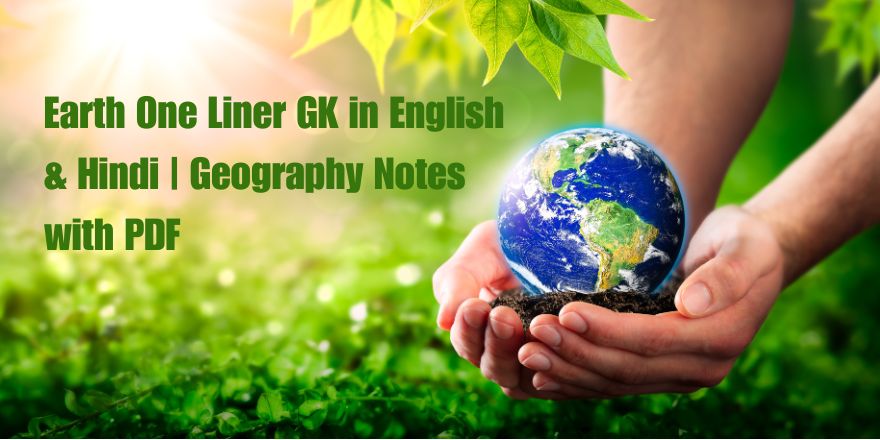Home › Geography › Earth One-Liner GK
Earth Geography – One-Liner GK (English + Hindi) + PDF
High-yield one-liners on Earth’s shape, size, latitudes & longitudes, time zones, tilt, rotation, seasons, solstices, and equinoxes. Perfect for UPSC, SSC CGL, Railways, Banking, and State PSC.
Contents
Numbered One-Liners (English + Hindi)
- Earth is an oblate spheroid, slightly flattened at the poles.
पृथ्वी एक चपटी अंडाकार (ओब्लेट स्फेरॉयड) है, ध्रुवों पर थोड़ी चपटी। - Equatorial diameter ≈ 12,756 km.
पृथ्वी का विषुवतीय व्यास लगभग 12,756 कि.मी. है। - Polar diameter ≈ 12,714 km.
पृथ्वी का ध्रुवीय व्यास लगभग 12,714 कि.मी. है। - Equatorial circumference ≈ 40,075 km.
विषुवतीय परिधि लगभग 40,075 कि.मी. है। - Polar circumference ≈ 40,008 km.
ध्रुवीय परिधि लगभग 40,008 कि.मी. है। - Mean radius ≈ 6,371 km.
औसत त्रिज्या 6,371 कि.मी. है। - Surface area ≈ 510.1 million sq. km.
पृष्ठ क्षेत्रफल लगभग 510.1 मिलियन वर्ग कि.मी. है। - About 71% of Earth’s surface is water.
पृथ्वी की सतह का लगभग 71% भाग पानी है। - Equator is at 0° latitude.
विषुवत रेखा 0° अक्षांश पर है। - Prime Meridian is at 0° longitude.
प्रधान मध्यान्ह रेखा 0° देशांतर पर है। - Tropic of Cancer: 23.5° N.
कर्क रेखा 23.5° उत्तर पर। - Tropic of Capricorn: 23.5° S.
मकर रेखा 23.5° दक्षिण पर। - Arctic Circle: 66.5° N; Antarctic Circle: 66.5° S.
आर्कटिक वृत्त 66.5° उ.; अंटार्कटिक वृत्त 66.5° द. - Latitudes run parallel to the Equator; longitudes meet at the poles.
अक्षांश समानांतर चलते हैं; देशांतर ध्रुवों पर मिलते हैं। - Earth has 24 standard time zones; each spans 15° longitude.
पृथ्वी पर 24 समय क्षेत्र; हर एक 15° चौड़ा। - One rotation ≈ 23h 56m; relative to the Sun: 360° in 24h.
एक घूर्णन 23घं 56मि; सूर्य के सापेक्ष 24घं में 360°। - Rotation rate: 15°/hour (i.e., 1°/4 minutes).
घूर्णन दर: 15°/घं (या 1°/4 मिनट)। - Direction of rotation: West → East.
घूर्णन दिशा: पश्चिम → पूर्व। - Axial tilt: 23.5° from the perpendicular.
धुरी का झुकाव: लंबवत से 23.5°। - Satellites confirmed Earth’s true shape.
उपग्रहों ने पृथ्वी के वास्तविक आकार की पुष्टि की। - International Date Line runs near 180° longitude and bends around landmasses.
अंतर्राष्ट्रीय तिथि रेखा 180° के पास है और स्थलभागों को घेरती है। - Crossing east → calendar decreases by a day; west → increases by a day.
पूर्व की ओर पार करें → एक दिन कम; पश्चिम की ओर → एक दिन बढ़ता है। - Greenwich (UK) is the reference for UTC/GMT.
ग्रीनविच (UK) विश्व समय (UTC/GMT) का आधार है। - IST is set at 82.5° E and equals GMT +5:30.
भारतीय मानक समय 82.5° पू. पर आधारित है और GMT +5:30 है। - Leap year repeats every 4 years except centuries not divisible by 400.
लीप वर्ष 4-4 साल में आता है; पर 400 से विभाज्य न होने वाली शताब्दियाँ लीप नहीं। - Revolution period ≈ 365.242 days; orbit is elliptical with slight eccentricity.
परिक्रमा अवधि लगभग 365.242 दिन; कक्षा दीर्घवृत्ताकार। - Perihelion: around 3–5 January; Aphelion: around 4–6 July.
उपसौर: 3–5 जनवरी; अपसौर: 4–6 जुलाई। - Revolution drives seasons; rotation causes day & night.
परिक्रमा से ऋतुएँ; घूर्णन से दिन-रात। - Summer solstice ≈ 21 June; Winter solstice ≈ 21 December.
ग्रीष्म अयनांत ≈ 21 जून; शीत अयनांत ≈ 21 दिसंबर। - Vernal equinox ≈ 21 March; Autumnal equinox ≈ 23 September.
वसंत विषुव ≈ 21 मार्च; शरद विषुव ≈ 23 सितंबर। - At equinox, day and night are nearly equal worldwide.
विषुव पर दिन-रात लगभग बराबर होते हैं। - Solstice marks the year’s longest/shortest day.
अयनांत सबसे लंबा/सबसे छोटा दिन दर्शाता है। - Midnight Sun occurs in polar summer; Polar Night in polar winter.
मध्यरात्रि सूर्य ध्रुवीय गर्मियों में; ध्रुवीय रात्रि सर्दियों में। - Earth bulges slightly at the Equator due to rotation.
घूर्णन से विषुवत पर हल्का उभार होता है। - Rotational speed at the Equator ≈ 1,670 km/h (~465 m/s).
विषुवत पर घूर्णन गति ≈ 1,670 कि.मी./घं. (~465 मी./से.)। - GPS uses latitude & longitude for global positioning.
GPS स्थान निर्धारण के लिए अक्षांश-देशांतर का उपयोग करता है।
Quick Recap (Exam Focus)
- Shape: Oblate spheroid • Water: 71%
- Tilt: 23.5° • Time zones: 24 • Rotation: 23h 56m
- Orbit: ~365.242 days • Key dates: Solstice (21 Jun/21 Dec), Equinox (21 Mar/23 Sep)
📲 Download Roy Academy App📑 Get the PDF
FAQs – Earth (Geography GK)
What is Earth’s exact shape?
Earth is an oblate spheroid: slightly flattened at the poles and bulged at the Equator due to rotation.
How many standard time zones are there?
There are 24 standard time zones, each roughly 15° of longitude wide.
Why do seasons change?
Because of Earth’s 23.5° axial tilt and its yearly revolution around the Sun.
Disclosure & Educational Use
This page is created for educational purposes to help students prepare for competitive exams. Some outbound links may be affiliate links. If you purchase through them, we may earn a small commission at no extra cost to you. We do not ask or encourage users to click on ads.
What to Read Next
Recommended Study Aids
- Atlas & Map Workbook (external)
- Geography Objective Guide (external)
These are affiliate links; purchases may support our free content.
[Ad will appear here after AdSense approval]
